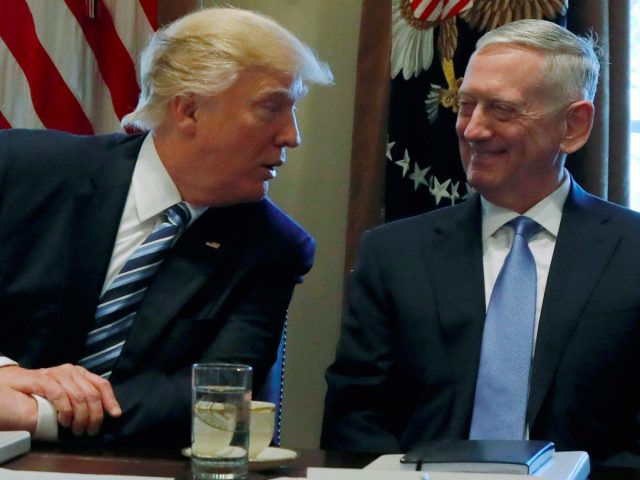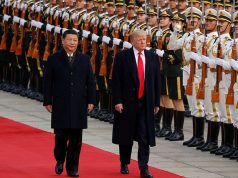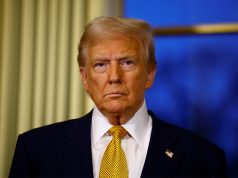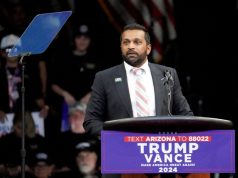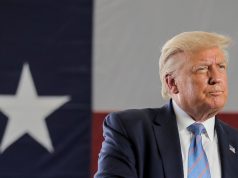WASHINGTON/SEOUL — President Donald Trump on Wednesday declared “talking is not the answer” to the tense standoff with North Korea over its nuclear missile development, but his defense chief swiftly asserted that diplomatic options remain and Russia demanded U.S. restraint.
Trump’s comment, a day after Pyongyang fired a ballistic missile over Japan that drew U.N. and other international condemnation, renewed his tough rhetoric toward reclusive, nuclear-armed and increasingly isolated North Korea.
“The U.S. has been talking to North Korea, and paying them extortion money, for 25 years,” Trump, who just last week said North Korean leader Kim Jong Un was “starting to respect” the United States, wrote on Twitter. “Talking is not the answer!”
When asked by reporters just hours later if the United States was out of diplomatic solutions with North Korea amid rising tensions after a series of missile tests by Pyongyang, U.S. Defense Secretary Jim Mattis replied: “No.”
“We are never out of diplomatic solutions,” Mattis said before a meeting with his South Korean counterpart at the Pentagon. “We continue to work together, and the minister and I share a responsibility to provide for the protection of our nations, our populations and our interests.”
Russian Foreign Minister Sergei Lavrov spoke by telephone with U.S. Secretary of State Rex Tillerson and urged the United States to refrain from any military action on the Korean peninsula that would be “fraught with unpredictable consequences,” Russia’s Foreign Ministry said.
Trump, who has vowed not to let North Korea develop nuclear missiles that can hit the mainland United States, had said on Tuesday “all options are on the table,” a veiled reference to military force.
Lavrov also said Russia, which wields veto power on the U.N. Security Council, believed any further sanctions on North Korea would be counter-productive, it added.
Japan urged fresh sanctions. In Geneva, U.S. disarmament ambassador Robert Wood said discussions were under way among world powers on what kind of further sanctions could imposed.
North Korea said the launch of an intermediate-range ballistic missile on Tuesday was to counter U.S. and South Korean military drills and was a first step in military action in the Pacific on “containing” the U.S. island territory of Guam.
The 15-member U.N. Security Council on Tuesday condemned the firing of the missile over Japan as “outrageous,” and demanded that North Korea halt its weapons program but the U.S.-drafted statement did not threaten new sanctions.
Trump’s mention of payments to North Korea appeared to be a reference to previous U.S. aid to Pyongyang.
A U.S. Congressional Research Service report said that between 1995 and 2008, the United States provided North Korea with more than $1.3 billion in assistance, mostly for food and energy. The aid was part of a nuclear deal that North Korea later violated.
The latest tweet by the Republican U.S. president drew criticism from some quarters in Washington. Democratic Senator Chris Murphy wrote on Twitter: “Bar is high, but this is perhaps the most dangerous, irresponsible tweet of his entire Presidency. Millions of lives at stake — not a game.”
Mattis and Tillerson have emphasized finding a diplomatic solution on North Korea, and have used softer tones than Trump on this and other matters.
For example, days after Trump vowed on Aug. 8 to unleash “fire and fury” against North Korea if it threatened the United States, the two wrote a Wall Street Journal commentary assuring Pyongyang that “The U.S. has no interest in regime change or accelerated reunification of Korea.”
North Korea had threatened to fire four missiles into the sea near Guam, home to a major U.S. military presence, after Trump’s “fire and fury” remark.
‘Key milestone’
The Pentagon’s Missile Defense Agency and the crew of the guided-missile destroyer USS John Paul Jones conducted a “complex missile defense flight test” off Hawaii early on Wednesday, resulting in the intercept of a medium-range ballistic missile target, the agency said.
The agency’s director, Lieutenant General Sam Greaves, called the test “a key milestone” in giving U.S. Navy Aegis Ballistic Missile Defense ships an enhanced capability, but did not mention North Korea.
The United States and South Korea are technically still at war with North Korea because their 1950-53 conflict ended in a truce, not a peace treaty. North Korea routinely says it will never give up its weapons programs, calling them necessary to counter perceived American hostility.
North Korea has conducted numerous ballistic missile tests in defiance of U.N. sanctions, but firing a projectile over mainland Japan was a rare and provocative move.
Japan pushed the United States on Wednesday to propose new U.N. Security Council sanctions on North Korea, which diplomats said could target the country’s laborers working abroad, oil supply and textile exports. Diplomats expected resistance from Russia and fellow veto-wielding power China, particularly given new measures were only recently imposed after Pyongyang staged two long-range missile launches in July.
Trump and Japanese Prime Minister Shinzo Abe spoke by telephone and confirmed their “continuing, close cooperation” regarding Pyongyang’s latest launch, the White House said.
Speaking during a visit to the Japanese city of Osaka, British Prime Minister Theresa May called on China, North Korea’s main ally and trading partner, to put more pressure on North Korea, echoing Trump’s view.
Asked about her comments, Chinese Foreign Ministry spokeswoman Hua Chunying said that some “relevant sides,” when it comes to sanctions, “storm to the front, but when it comes to pushing for peace they hide at the very back.”

